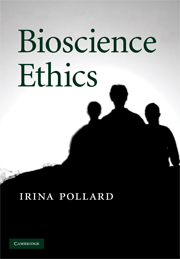Book contents
- Frontmatter
- Contents
- Preface
- Acknowledgements
- 1 Human origins, natural selection and the evolution of ethics
- 2 Sex determination, brain sex and sexual behaviour
- 3 Inappropriate lifestyle and congenital disability in children: basic principles of growth, toxicology, teratogenesis and mutagenesis
- 4 Substance abuse and parenthood: biological mechanisms – bioethical responsibilities
- 5 Fertility awareness: the ovulatory method of birth control, ageing gametes and congenital malformation in children
- 6 Understanding child abuse and its biological consequences
- 7 The state of wellbeing: basic principles, coping strategies and individual mastery
- 8 The state of wellbeing: on the end-of-life care and euthanasia
- 9 Current reproductive technologies: achievements and desired goals
- 10 The recombinant DNA technologies
- 11 Stem cells, nuclear transfer and cloning technology
- 12 Human-dominated ecosystems: re-evaluating environmental priorities
- 13 Human-dominated ecosystems: reclaiming the future for following generations
- 14 Human-dominated ecosystems: warfare = fitness enhancement or losing strategy?
- 15 Human-dominated ecosystems: reworking bioethical frontiers
- Further reading
- Index
10 - The recombinant DNA technologies
Published online by Cambridge University Press: 17 February 2010
- Frontmatter
- Contents
- Preface
- Acknowledgements
- 1 Human origins, natural selection and the evolution of ethics
- 2 Sex determination, brain sex and sexual behaviour
- 3 Inappropriate lifestyle and congenital disability in children: basic principles of growth, toxicology, teratogenesis and mutagenesis
- 4 Substance abuse and parenthood: biological mechanisms – bioethical responsibilities
- 5 Fertility awareness: the ovulatory method of birth control, ageing gametes and congenital malformation in children
- 6 Understanding child abuse and its biological consequences
- 7 The state of wellbeing: basic principles, coping strategies and individual mastery
- 8 The state of wellbeing: on the end-of-life care and euthanasia
- 9 Current reproductive technologies: achievements and desired goals
- 10 The recombinant DNA technologies
- 11 Stem cells, nuclear transfer and cloning technology
- 12 Human-dominated ecosystems: re-evaluating environmental priorities
- 13 Human-dominated ecosystems: reclaiming the future for following generations
- 14 Human-dominated ecosystems: warfare = fitness enhancement or losing strategy?
- 15 Human-dominated ecosystems: reworking bioethical frontiers
- Further reading
- Index
Summary
… eugenics and genetics, they are clearly related.
Genetic engineering and related technologies – biological perspective
Recent developments in genetic engineering have brought an unprecedented increase in our power over living things. Gene mapping, together with recombinant excising and splicing techniques, holds great promise for producing new kinds of plants, animals, drugs and for treating human genetic diseases. Transgenic plants and animals are genetically novel creatures because they carry integrated foreign genes, which are correctly expressed and inherited by subsequent generations. Modern biotechnology had its beginnings in 1973 when Herb Boyer and Stanley Cohen genetically engineered a human gene into bacteria that then produced that gene's product – in this case human insulin, which was then purified for therapeutic use. Prior to this breakthrough, individuals suffering from diabetes were treated with insulin derived from the pancreases of abattoir animals, usually pigs and cows. Needless to say, the medical and industrial possibilities were immediately recognized and venture capital was invested to create companies with the aim of genetically modifying organisms to mass-produce desired hormones, drugs, vaccines, etc. Among the many important human proteins now produced in this way are growth and fertility hormones, blood-clotting factors to treat haemophilia, and hepatitis B vaccine.
The technology used to produce transgenic organisms is known as recombinant DNA technology, or more popularly as genetic engineering and cloning. ‘Recombinant DNA’ means DNA made up of connected segments from mixed sources; for example, from different species or a combination of natural and synthetic DNA. Recombinant DNA technology has revolutionized experimental biology by advancing understanding of gene construction and regulation and through applications in agriculture, veterinary science, medicine, forensics and environmental pollution.
- Type
- Chapter
- Information
- Bioscience Ethics , pp. 171 - 191Publisher: Cambridge University PressPrint publication year: 2009

